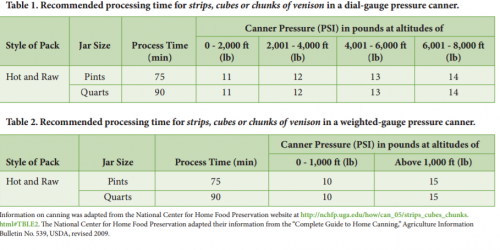Be prepared for incoming venison: Part 2
Ensure venison in your cupboards is properly preserved.
Hunting season is here and many Michigan residents will be filling their cupboards with canned venison. If you are one of the lucky ones who harvested more than one deer, you need to make sure you have taken the proper steps to safely prepare for preserving the venison. In part one, we looked at the best freezing and storing practices for venison.
If you plan to can your venison or other meat, such as fish or poultry, you will want to make sure your pressure canner is in top working order. All low acid foods (meat) must be pressure canned to be safe to consume later. If you have a weighted gauge canner, check your seal, vents and make sure the equipment is clean and in working order. If you have a dial gauge pressure canner, your gauge should be checked once a year to ensure accuracy. A dial gauge that is off by more than 2 pounds of pressure may not be processing safely and could make your family sick. Most gauges can be checked by most local Extension offices, call to learn what you need to do.
Guidelines for processing wild game
- Do not can unless you have a pressure canner.
- Can fresh meat within 2 days, if this is not possible, freeze it until you are able to preserve it. (To can frozen meat, thaw in the refrigerator until most of the ice crystals are gone.)
- Always follow a research tested recipe; proper time and pressure are important for a safe end product.
- Meat can be processed in strips, cubes or chunks – choose quality chilled venison. Remove excess fat.
- Soak strong-flavored wild meats for 1 hour in brine water (1 tablespoon salt per 1 quart of water). Rinse. Remove large bones.
- Hot Pack – precook meat until rare by roasting, stewing or browning in a small amount of fat. Add 1 teaspoon of salt per quart jar, if desired. Fill jars with pieces and add boiling broth, meat drippings, water or tomato juice, leaving 1-inch headspace.
- Raw Pack- add 1 teaspoon of salt per quart jar if desired. Fill jars with raw meat pieces, leaving 1-inch headspace. Do not add liquid.
Processing times

Michigan State University Extension suggests letting jars stand undisturbed for 24 hours, removing rings, washing jars, labeling, dating and storing. If a jar doesn’t seal, reprocess within 24 hours using the same processing time. Store the jars between 50 and 70 degrees Fahrenheit in a clean, cool, dark, dry place. Use within one year. Enjoy your venison, just make sure you have taken steps to safely preserve it.



 Print
Print Email
Email




